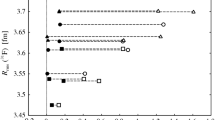Abstract
Structure of two-neutron halo in light exotic nuclei is studied by a three-body model using the neutron–neutron interaction fixed at the low-energy scattering limit. The model is applied to the dripline nucleus \(^{22}\)C assuming a pure s-wave halo with “correlated” \(^{20}\)C-core, and a unique relation between two-neutron separation energy and halo radius is derived. It is also applied to \(^{29}\)F, where 2\(p_{3/2}\)-orbit is shown to be important for forming the halo. The estimated halo radii in \(^{22}\)C and \(^{29}\)F are found to be consistent with the recent experimental data. The halos in \(^{17}\)B and \(^{19}\)B are analyzed by the three-body model with mixed configurations of 2\(s_{1/2}^{2}\) and 1\(d_{5/2}^{2}\). The dominance of the d-orbit is found in \(^{17}\)B, while the s-orbit component is found to be about 40\(\%\) in \(^{19}\)B.



Similar content being viewed by others
References
T. Suzuki, T. Otsuka, C. Yuan, A. Navin, Two-neutron halo from the low-energy limit of neutron-neutron interaction: applications to drip-line nuclei \(^{22}\)C and \(^{24}\)O. Phys. Lett. B 753, 199 (2016)
A. Bohr, B.R. Mottelson, Nuclear Structure, vol. 1 (Benjamin, New York, 1969).
R. Machleid, High-precision charge-dependent Bonn nucleon-nucleon potential. Phys. Rev. C 63, 024001 (2001)
N. Kobayashi et al., One- and two-neutron removal reactions from the most neutron-rich carbon isotopes. Phys. Rev. C 86, 054604 (2012)
C. Yuan et al., Shell-model study of boron, carbon, nitrogen and oxygen isotopes with a monopole-based universal interaction. Phys. Rev. C 85, 064324 (2012)
Y. Togano et al., Interaction cross section study of the two-neutron halo nucleus \(^{22}\)C. Phys. Lett. B 761, 412 (2016)
A. Ozawa et al., Nuclear size and related topics. Nucl. Phys. A 693, 21 (2001)
T. Suzuki et al, Formation of two-neutron halo in light drip-line nuclei from the low-energy neutron-neutron interaction, PoS INPC2016, 055 (2017)
National Nuclear Data Center, http://www.ndc.bnl.gov/nudat2/
S. Bagchi et al., Two-neutron halo is unveiled in \(^{29}\)F. Phys. Rev. Lett. 124, 222504 (2020)
N. Tsunoda et al., Exotic neutron-rich medium-mass nuclei with realistic nuclear forces. Phys. Rev. C 95, 021304(R) (2017)
D.R. Entem, R. Machleidt, Accurate charge-dependent nucleon-nucleon potential at fourth order of chiral perturbation theory. Phys. Rev. C 68, 041001(R) (2003)
K. Takayanagi, Effective Hamiltonian in the extended Krenciglowa-Kuo method. Nucl. Phys. A 864, 91 (2011)
J. Fujita, H. Miyazawa, Pion theory of three-body forces. Prog. Theor. Phys. 17, 360 (1957)
B.A. Brown, B.H. Wildenthal, Status of the nuclear shell model. Ann. Rev. Nucl. Part. Sci. 38, 29 (1988)
Z.H. Yang et al., Quasifree neutron knockout reaction reveals a small s-orbital component in the Borromean nucleus \(^{17}\)B. Phys. Rev. Lett. 126, 082501 (2021)
G. Audi et al., The Nubase evaluation of nuclear and decay properties. Nucl. Phys. A 624, 1 (1997)
T. Suzuki et al., Momentum distribution of \(^{15}\)B fragments from the breakup of \(^{17}\)B. Phys. Rev. Lett. 89, 012501 (2002)
L. Gaudefroy et al., Direct mass measurements of \(^{19}\)B, \(^{22}\)C, \(^{29}\)F, \(^{31}\)Ne, \(^{34}\)Na and other light exotic nuclei. Phys. Rev. Lett. 109, 202503 (2012)
T. Suzuki et al., Nuclear radii of \(^{17,19}\)B and \(^{14}\)Be. Nucl. Phys. A 658, 313 (1999)
K.J. Cook et al., Halo structure of the neutron-dripline nucleus \(^{19}\)B. Phys. Rev. Lett. 124, 212503 (2020)
J. Casal, E. Garrido, Three-body structure of \(^{19}\)B: Finite-range effects in two-neutron halo nuclei. Phys. Rev. C 102, 051304(R) (2020)
A. Spyrou et al., First evidence for a virtual \(^{18}\)B ground state. Phys. Lett. B 683, 129 (2010)
E. Hiyama, R. Lazauskas, F. M. Marques, J. Carbonell, Modelling \(^{19}\)B as a \(^{17}\)B-n-n three-body system in the unitary limit, Phys. Rev. C 100, 011603 (R) (2019)
Author information
Authors and Affiliations
Corresponding author
Additional information
Publisher's Note
Springer Nature remains neutral with regard to jurisdictional claims in published maps and institutional affiliations.
Rights and permissions
About this article
Cite this article
Suzuki, T., Otsuka, T. Structure of Two-Neutron Halo in Light Exotic Nuclei. Few-Body Syst 62, 32 (2021). https://doi.org/10.1007/s00601-021-01612-5
Received:
Accepted:
Published:
DOI: https://doi.org/10.1007/s00601-021-01612-5




